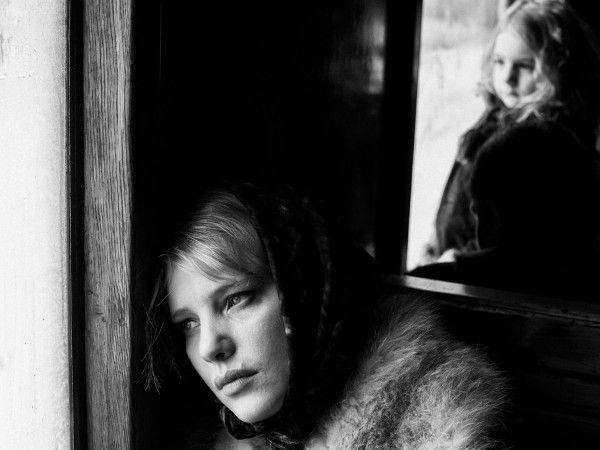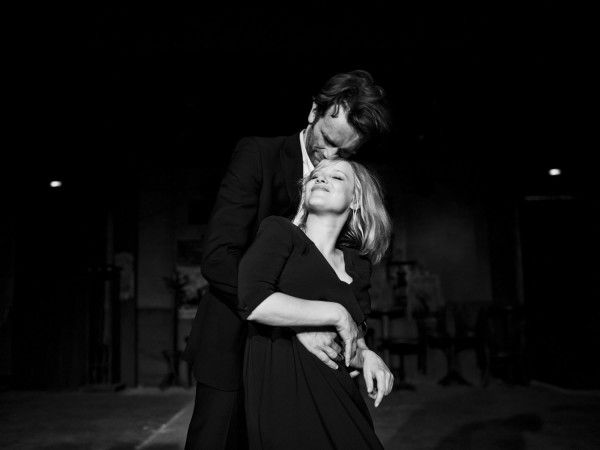Zula (Joanna Kulig) is depressed. The love of her life, Wiktor (Tomasz Kot), is seemingly ignoring her, more interested in talking to a colleague at a Parisian club after she’s spent years trying to cross East-West lines to be with him. She leans on a bar as a melancholy song plays, seemingly too appropriate for her mood at that particular moment. Unexpectedly, someone in the club puts a recording of Bill Hayley and the Comet’s “Rock Around The Clock” on. With a euphoric glow Zula comes to life and spins her way onto the dance floor. She swing dances from gentleman to gentleman until she finally ends up on the bar whipping her dress around to the delight of the crowd and, sadly, Wiktor’s resignation.
Director Pawel Pawlikoski and cinematographer Lukasz Żal accomplish all of this in what feels like one shot, and what could have seemed like a cliché musical moment feels unexpectedly fresh and new. That’s not only because of Pawlikowski’s vision, but an incredible breakthrough performance from Kulig. The two are a match made in cinematic heaven and transform the stunning Cold War (which debuted at the 2018 Cannes Film Festival on Friday) into a film that lingers with you hours after the final credits roll.
As Pawlikowski’s follow up to 2015’s Oscar-winning Ida, his latest masterwork was actually inspired by the contentious relationship of his own parents. Beyond the use of their real first names, however, Pawlikowski created fictional backgrounds and events to chronicle their emotional beats of their on-again, off-again romance. The story begins in 1949 where Wiktor, a pianist and composer, and Irena (Agata Kulesza), seemingly everything else, are roaming the Polish countryside to form what will become Mazowsze, a folk group to represent the best of the newly communist nation (and still exists today). Well, that’s the goal at least of Kaczmarek (Borys Szyc), the government supervisor overseeing Wiktor and Agata. Out of all the girls who audition, the blunt Zula has an energy that sets her apart from the others even if Irena is suspicious of her. Then again, who wouldn’t be? She was jailed for almost killing her father (you can guess why). Wiktor, on the other hand, immediately sparks to her.
Fast forward a year or two and a secret romance between Wiktor and Zulu is blossoming just as the latter becomes an up and coming propaganda for the Polish government. It’s during the troupe’s first performance in Berlin where Wiktor devises a plan for the pair to cross into a Western controlled zone so they can finally be together. He shows up at their set meeting point and she, much to his dismay, does not. It will haunt both of them for the rest of their lives. Even they somehow found a way to escape the political intrigue to reunite again and again over the next decade.
But that dance number we mentioned previously. It needs more context. In the late ‘50s Zulu marries an Italian cut glass exporter (who we intentionally never meet on screen) which allows her to travel to Paris (it turns out Poles could marry non-Soviet Bloc citizens and freely leave the country). This period encapsulates the highs and lows in their love affair and musical collaborations. As Wiktor expected, Zulu’s talent makes her popular in his creative circle and it leads to a French recording that, at worst, should be the start of European stardom. But, as with Pawlikowsk’s own experience with his parents he is intent on reminding everyone that often true love is not an easy path. Especially in this time period of deep ideological conflict.
The 35-year-old Kulig is already known to Polish television and film audiences, but it goes without saying that her performance in here is simply a revelation as she crafts Zulu into a multi-layered character who is conflicted at almost every turn. You can argue she generates more of the chemistry between the star-crossed lovers than Kot does and, frankly, that’s probably because the film comes alive whenever she’s on screen (and Kot’s strangely subdued performance might have something to do with it as well). Kulig can also legitimately sing which makes her character’s rise from incarcerated peasant girl to one of Poland’s most celebrated vocalists easy to believe.
As with Ida, Pawlikowski and Żal film the proceedings in black and white and in a “square” 1:1.33 aspect ratio. The imagery they create is haunting (an evening boat ride on la seine river in Paris sticks with you) and they are aided by some award-worthy production design from Katarzyna Sobańska and Marcel Sławiński and striking costumes by Aleksandra Staszko. An overall creative team whose task wasn’t made easier by the choice not to shoot in color.
Cold War will only increase Pawlikowski’s reputation as one of the next great auteurs, but, more importantly, it will have everyone who sees it asking, “What’s that girl’s name?” Ladies and gentlemen, her name is Joanna Kulig has she has arrived.
Grade: A-



